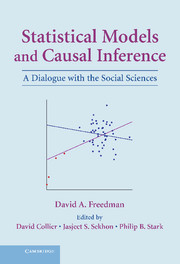Book contents
- Frontmatter
- Contents
- Preface
- Editors' Introduction: Inference and Shoe Leather
- Part I Statistical Modeling: Foundations and Limitations
- Part II Studies in Political Science, Public Policy, and Epidemiology
- Part III New Developments: Progress or Regress?
- 12 On Regression Adjustments in Experiments with Several Treatments
- 13 Randomization Does Not Justify Logistic Regression
- 14 The Grand Leap
- 15 On Specifying Graphical Models for Causation, and the Identification Problem
- 16 Weighting Regressions by Propensity Scores
- 17 On the So-Called “Huber Sandwich Estimator” and “Robust Standard Errors”
- 18 Endogeneity in Probit Response Models
- 19 Diagnostics Cannot Have Much Power Against General Alternatives
- Part IV Shoe Leather Revisited
- References and Further Reading
- Index
15 - On Specifying Graphical Models for Causation, and the Identification Problem
Published online by Cambridge University Press: 05 June 2012
- Frontmatter
- Contents
- Preface
- Editors' Introduction: Inference and Shoe Leather
- Part I Statistical Modeling: Foundations and Limitations
- Part II Studies in Political Science, Public Policy, and Epidemiology
- Part III New Developments: Progress or Regress?
- 12 On Regression Adjustments in Experiments with Several Treatments
- 13 Randomization Does Not Justify Logistic Regression
- 14 The Grand Leap
- 15 On Specifying Graphical Models for Causation, and the Identification Problem
- 16 Weighting Regressions by Propensity Scores
- 17 On the So-Called “Huber Sandwich Estimator” and “Robust Standard Errors”
- 18 Endogeneity in Probit Response Models
- 19 Diagnostics Cannot Have Much Power Against General Alternatives
- Part IV Shoe Leather Revisited
- References and Further Reading
- Index
Summary
Abstract. Graphical models for causation can be set up using fewer hypothetical counterfactuals than are commonly employed. Invariance of error distributions may be essential for causal inference, but the errors themselves need not be invariant. Graphs can be interpreted using conditional distributions so that one can better address connections between the mathematical framework and causality in the world. The identification problem is posed in terms of conditionals. As will be seen, causal relationships cannot be inferred from a data set by running regressions unless there is substantial prior knowledge about the mechanisms that generated the data. There are few successful applications of graphical models, mainly because few causal pathways can be excluded on a priori grounds. The invariance conditions themselves remain to be assessed.
In this chapter, I review the logical basis for inferring causation from regression equations, proceeding by example. The starting point is a simple regression, next is a path model, and then simultaneous equations (for supply and demand). After that come nonlinear graphical models.
The key to making a causal inference from nonexperimental data by regression is some kind of invariance, exogeneity being a further issue. Parameters need to be invariant to interventions. This well-known condition will be stated here with a little more precision than is customary. Invariance is also needed for errors or error distributions, a topic that has attracted less attention.
- Type
- Chapter
- Information
- Statistical Models and Causal InferenceA Dialogue with the Social Sciences, pp. 255 - 278Publisher: Cambridge University PressPrint publication year: 2009

